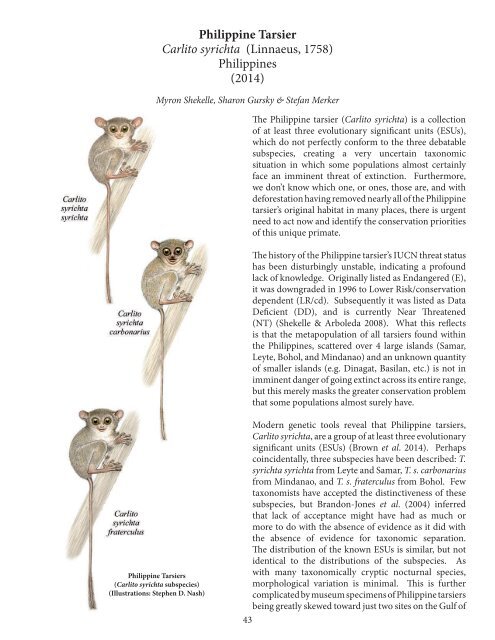Primates in Peril
f12q6x
f12q6x
You also want an ePaper? Increase the reach of your titles
YUMPU automatically turns print PDFs into web optimized ePapers that Google loves.
Philipp<strong>in</strong>e Tarsier<br />
Carlito syrichta (L<strong>in</strong>naeus, 1758)<br />
Philipp<strong>in</strong>es<br />
(2014)<br />
Myron Shekelle, Sharon Gursky & Stefan Merker<br />
The Philipp<strong>in</strong>e tarsier (Carlito syrichta) is a collection<br />
of at least three evolutionary significant units (ESUs),<br />
which do not perfectly conform to the three debatable<br />
subspecies, creat<strong>in</strong>g a very uncerta<strong>in</strong> taxonomic<br />
situation <strong>in</strong> which some populations almost certa<strong>in</strong>ly<br />
face an imm<strong>in</strong>ent threat of ext<strong>in</strong>ction. Furthermore,<br />
we don’t know which one, or ones, those are, and with<br />
deforestation hav<strong>in</strong>g removed nearly all of the Philipp<strong>in</strong>e<br />
tarsier’s orig<strong>in</strong>al habitat <strong>in</strong> many places, there is urgent<br />
need to act now and identify the conservation priorities<br />
of this unique primate.<br />
The history of the Philipp<strong>in</strong>e tarsier’s IUCN threat status<br />
has been disturb<strong>in</strong>gly unstable, <strong>in</strong>dicat<strong>in</strong>g a profound<br />
lack of knowledge. Orig<strong>in</strong>ally listed as Endangered (E),<br />
it was downgraded <strong>in</strong> 1996 to Lower Risk/conservation<br />
dependent (LR/cd). Subsequently it was listed as Data<br />
Deficient (DD), and is currently Near Threatened<br />
(NT) (Shekelle & Arboleda 2008). What this reflects<br />
is that the metapopulation of all tarsiers found with<strong>in</strong><br />
the Philipp<strong>in</strong>es, scattered over 4 large islands (Samar,<br />
Leyte, Bohol, and M<strong>in</strong>danao) and an unknown quantity<br />
of smaller islands (e.g. D<strong>in</strong>agat, Basilan, etc.) is not <strong>in</strong><br />
imm<strong>in</strong>ent danger of go<strong>in</strong>g ext<strong>in</strong>ct across its entire range,<br />
but this merely masks the greater conservation problem<br />
that some populations almost surely have.<br />
Philipp<strong>in</strong>e Tarsiers<br />
(Carlito syrichta subspecies)<br />
(Illustrations: Stephen D. Nash)<br />
Modern genetic tools reveal that Philipp<strong>in</strong>e tarsiers,<br />
Carlito syrichta, are a group of at least three evolutionary<br />
significant units (ESUs) (Brown et al. 2014). Perhaps<br />
co<strong>in</strong>cidentally, three subspecies have been described: T.<br />
syrichta syrichta from Leyte and Samar, T. s. carbonarius<br />
from M<strong>in</strong>danao, and T. s. fraterculus from Bohol. Few<br />
taxonomists have accepted the dist<strong>in</strong>ctiveness of these<br />
subspecies, but Brandon-Jones et al. (2004) <strong>in</strong>ferred<br />
that lack of acceptance might have had as much or<br />
more to do with the absence of evidence as it did with<br />
the absence of evidence for taxonomic separation.<br />
The distribution of the known ESUs is similar, but not<br />
identical to the distributions of the subspecies. As<br />
with many taxonomically cryptic nocturnal species,<br />
morphological variation is m<strong>in</strong>imal. This is further<br />
complicated by museum specimens of Philipp<strong>in</strong>e tarsiers<br />
be<strong>in</strong>g greatly skewed toward just two sites on the Gulf of<br />
43


